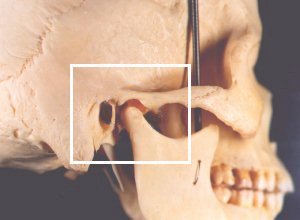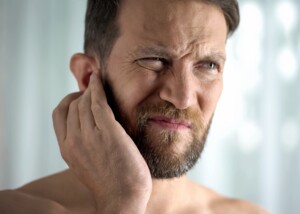
Do not let what seems like TMJ symptoms on only one side of your face frighten you into thinking that this means cancer.
Those who fear cancer or a tumor whenever a new symptom arises are prone to checking if it’s “on the other side,” since a one-sided symptom is more suggestive of cancer or a benign tumor than if it’s presenting on both sides, or bilaterally.
For example, tinnitus (ringing in the ears, which can be caused by TMJ disorder) that occurs on only one side (along with sudden hearing loss on only that side) is suspicious for a tumor inside the ear canal.
But when symptoms are bilateral, this brings a good degree of reassurance to those with health anxiety.
And symptoms involving the jaw, ears and mouth that occur on both sides, vs. one side, are no exception to this rule.
TMJ Disorder Symptoms: One Sided or Both Sides?
“There are three things that determine your bite: your teeth, your facial muscles and your temporomandibular joints,” says Jeffrey Haddad, DDS, of Doolin Haddad Advanced Dentistry in Rochester, MI.
“The teeth dominate the system, so wherever your teeth are, your TM joints and facial muscles must accommodate,” continues Dr. Haddad.
“Unfortunately, many times they must accommodate at a price which is a compressed condylar position in the glenoid fossa and muscular tension and pain.
“This can be confirmed with a 3D cone beam CT before the beginning of any treatment.
“It is an accepted fact in dentistry that 90% of all TMJ symptoms are muscular in origin.
“A person brings their teeth together three to 5,000 times per day, and if they have a poor occlusion [teeth contact], muscular tension and pain could result.
“Not only can symptoms occur on only one side, but this is actually more of the norm rather than the exception.
“The majority of human beings are not symmetrical, especially in the head and neck. In regards to the temporomandibular joints, this is extremely common.
“The mandible (lower jaw) is suspended by muscles and ligaments with no bony connection to the skull.

Larena, CreativeCommons
“It can move in six directions, like the motions of an airplane, and the only support of the jaw is the connection of the teeth of the upper and lower jaws.
“If a person has a misaligned bite, malpositioned teeth or a worn down dentition due to clenching and grinding, the mandible will be in a torqued and strained position.
“This can result in a jaw position that is too far backwards or compressed upwards in the glenoid fossa of the skull, and this rarely occurs in a symmetrical fashion.
“As mentioned above, 90% of all TMJ symptoms are muscular in nature, and muscular tension will result if the mandible is being forced into a strained posture.
“If it is positioned too far to the right, for instance, the person’s symptoms will definitely be more intense on the right side.
“Some patients experience symptoms on both sides, but the majority of all of the TMJ patients I have treated over the past 17 years have one side that is worse than the other.
“In order to identify a poor occlusion or jaw posture, we have many intraoral and extraoral signs that we look for in these patients.”
Symptoms of a “Destructive” Bite
• Worn down teeth (attrition)
• Fractured or missing teeth
• Abfractions (gum line tooth loss not due to decay)
• Large overbite (30% or greater)
• Large overjet (top front teeth point outward)
• Posteriorized mandible (retruded chin)
• Bony tori (bony growths in the jaws)
• Forward head posture
• Obstructed airway (e.g., large tongue base)

Dr. Haddad lectures nationally on cosmetic dentistry, TMJ disorders and practice marketing, and utilizes the latest technology to ensure the utmost in patient comfort and care.
 Lorra Garrick has been covering medical, fitness and cybersecurity topics for many years, having written thousands of articles for print magazines and websites, including as a ghostwriter. She’s also a former ACE-certified personal trainer.
Lorra Garrick has been covering medical, fitness and cybersecurity topics for many years, having written thousands of articles for print magazines and websites, including as a ghostwriter. She’s also a former ACE-certified personal trainer.
.









































